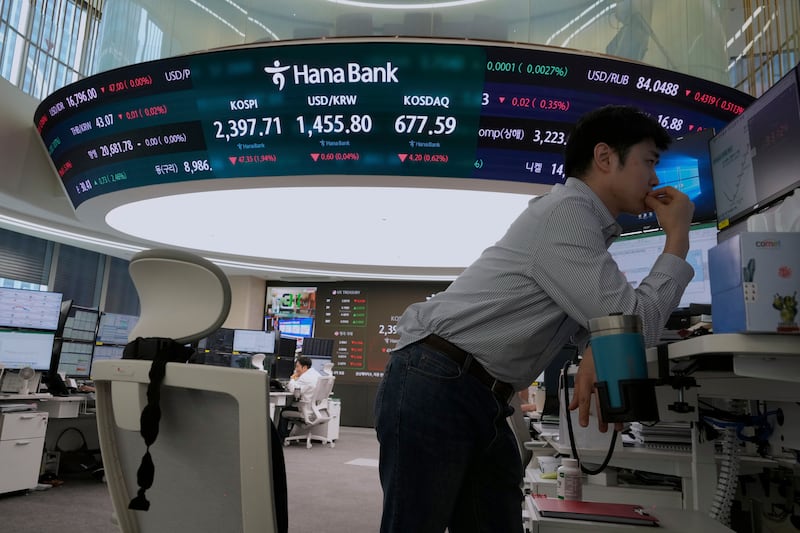The UK’s FTSE 100 index has risen more than 0.7 per cent at the start of trading as Asian stocks fell and the dollar sank further on Friday.
European markets are open and are – so far – in positive territory. The mid-cap FTSE 250 is up 0.4 per cent, while Italy’s FTSE MIB rose 0.9 per cent.
Mining companies are dominating the top of the index. Fresnillo is up 4.9 per cent, Endeavor Mining is up 3.7 per cent and Rio Tinto is up 1.9 per cent. Glencore is also among the biggest risers, up 1.6 per cent, while Antofagasta is up 1.5 per cent.
Earlier, a manic bond selloff took hold in a brutal end to the week of tit-for-tat worldwide tariffs that have fed fears of a deep recession and shaken investor confidence in US assets.

The anxiety sparked a rush into safe havens, sending the Swiss franc soaring to a decade high against the dollar, and gold to a new peak after a brief but massive relief rally following US president Donald Trump’s move to temporarily lower tariffs on many countries.
The selloff in US Treasuries picked up pace during Asian hours, with the 10-year note yield rising to 4.45 per cent, gaining about 45 basis points in the week, the biggest increase since 2001, LSEG data showed.
Analysts and investors have pointed to this week’s sharp selloff in Treasuries and weakness in the dollar as a sign of faltering confidence in the world’s biggest economy.
“There’s clearly an exodus from US assets. A falling currency and bond market is never a good sign,” said Kyle Rodda, senior financial markets analyst at Capital.com. “This goes beyond pricing in a growth slowdown and trade uncertainty.”
In Asia, Japan’s Nikkei tumbled 4.3 per cent on the day, while stocks in South Korea fell nearly 1 per cent. Taiwan’s main index reversed earlier losses to trade nearly 2 per cent higher.
US futures for S&P 500 and Nasdaq also reversed course to be slightly higher after a sharp drop overnight. European futures pointed to a higher open as nervous investors brace for volatility.
“The short-term outlook for global risk assets remains uncertain given growth and inflation concerns, fluid sentiments and fast-changing developments on the trade and tariff fronts,” said Vasu Menon, managing director of investment strategy at OCBC Bank in Singapore.
Investors are grappling with worries over the escalating Sino-US trade war after Trump ratcheted up tariffs on Chinese imports, raising them effectively to 145 per cent.
China has hit back, hiking its tariffs on the US with each Trump increase, raising fears that Beijing may jack up duties above the current 84 per cent.
Chinese stocks were relatively steady. The blue-chip CSI300 Index was 0.1 per cent lower while Hong Kong’s benchmark Hang Seng rose 0.56 per cent.
James Athey, fixed income manager at Marlborough, said the outlook remains darker and more clouded in uncertainty than it did a month ago. “There are still so many unanswered and unanswerable questions.”
The US dollar has faced relentless selling in the past few weeks, with traders seeking shelter in the Japanese yen, the Swiss franc as well as the euro .
On Friday, the dollar sank to its lowest in 10 years against the Swiss franc and a six-month low against the yen. The euro surged 1.7 per cent to $1.13855, a level last seen in February 2022.
The dollar index, which measures the greenback against six other units, fell below 100 for the first time since July 2023. The dollar’s slide provided relief to some of the currencies in emerging markets, including the ringgit.
Markets mostly shrugged off data from the US Labour Department that showed consumer prices unexpectedly fell in March although the improvement in inflation is unlikely to be sustained in the wake of tariffs.
Meanwhile, a violent US Treasury selloff this week, evoking the COVID-era “dash for cash”, had reignited fears of fragility in the world’s biggest bond market.
Thirty-year bond yields rose to 4.90 per cent, on course for their biggest weekly jump since at least 1982, LSEG data showed.
“What we are seeing in US bond markets is not currently about inflation concerns,” said Michael Krautzberger of Allianz Global Investors.
Mr Krautzberger said the price action in Treasuries could be reflecting investor fears that a sharp growth slowdown, or recession, “makes an already unsustainable US fiscal outlook even worse.”
“On the other hand, we could just be witnessing a rebalancing among institutional investors or a deleveraging from levered funds.”
In commodities, gold prices scaled a record high on safe haven flows. It was last up 1.1 per cent at $3,210 per ounce.
Oil prices slipped on Friday, set for second straight week in the red on concerns about a prolonged trade war between the United States and China.
US West Texas Intermediate crude futures fell 0.5 per cent, while Brent crude futures fell 0.6 per cent. – Reuters











